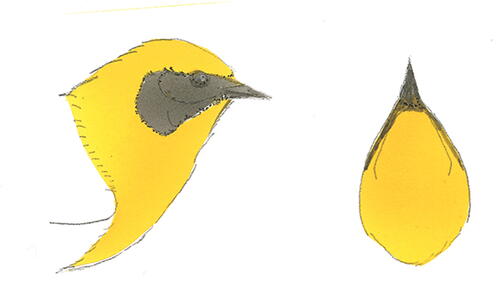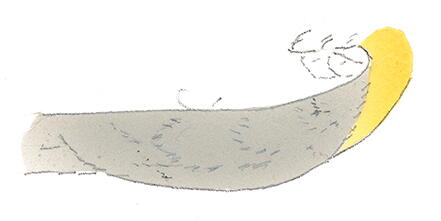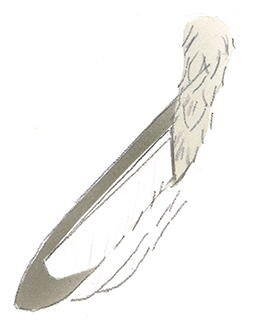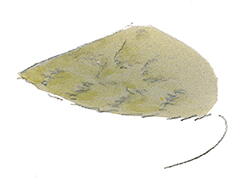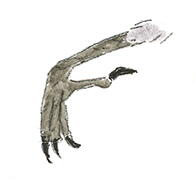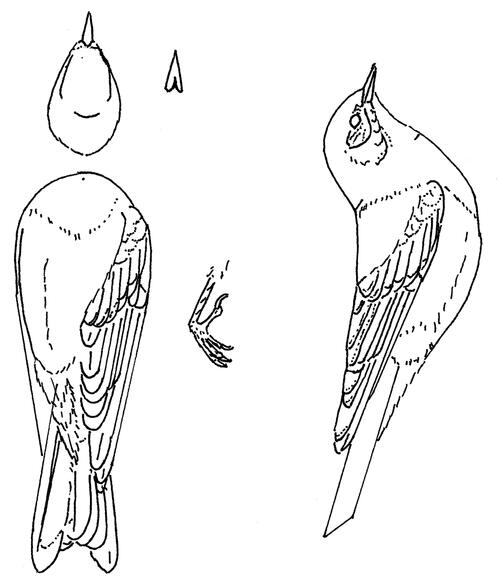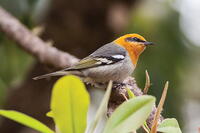Olive Warbler
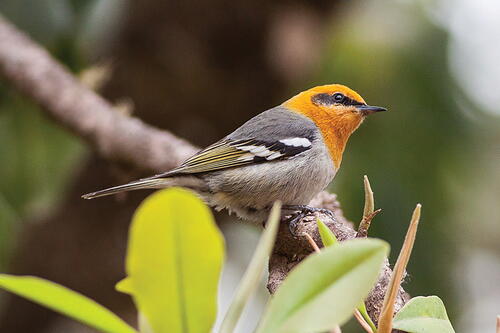
The olive warbler (Peucedramus taeniatus) has a yellow-orange head with a black ear patch. It is described as being relatively long, measuring between 5 and 5 1/2 inches in length, with a slender bill, long wings, and notched tail. The orange head of the adult male takes up to two years to develop.
The olive warbler feeds on flying insects, which it catches in midair, mainly in high pine forests, especially in the mountainous regions of Arizona and New Mexico. The measurements for the pattern and painting notes were taken from study skins provided by the School of Life Sciences at Arizona State University, in Tempe, Arizona
MEASUREMENTS (in mm)
Eyes: 4 (brown)
Wing chord: 84 (from the wrist to the tip of the longest primary feather)
Head width at the ear coverts: 15
Bill:
- Tip of the bill to the front of the eyes: 15
- Exposed culmen: 10
- Gape: 12; width: 6; bottom: 8
Tarsus: length: 16; width: 0.5; height: 1.25
Toes:
- Hallux: 6 (plus 6 for the nail)
- Middle: 11 (plus 5 for the nail)
- Inner: 4 (plus 4 for the nail)
- Outer: 5 (plus 4 for the nail)
Materials List
-
Paints
Jo Sonja
- Cadmium yellow medium
- Warm white
-
Liquitex
- Raw umber
- Yellow orange
- Raw sienna
-
M. Graham & Co.
- Mars black
- Cerulean blue
- Cadmium yellow light
-
Brushes
- #1 round or filbert
- #2 round or filbert
PAINT SWATCHES
-
After properly sealing your carving and applying an even coat of gesso (if you use gesso), allow it to dry. A water-based pencil works well to indicate where you paint the head-breast area and wing patch.
DIRECTIONS
-
CROWN, THROAT, AND UPPER PORTION OF THE BREAST
First, apply cadmium yellow light to the above area; when dry, apply a couple of washes of yellow-orange with a touch of raw sienna to slightly deepen the crown and throat area, leaving the area of the yellow light just above the mantle -
LORES, MALAR, EYE RING, AND EAR COVERTS
Apply 1 part Mars black, 2 parts raw umber -
MANTLE, SCAPULARS, RUMP, AND UPPER-TAIL COVERTS
Before applying this gray to the mantle, slightly dampen with water the area at the back of the head to prevent a hard paint line. Apply washes of 1 part Mars black, 2 parts warm white, 2 parts raw umber. If the paint blends too far into the back of the head, use another brush to wipe it away (some of the blend is okay, however). Once this area is dry, apply a diluted wash of equal parts cadmium yellow light and cerulean blue, with a small touch of cadmium red light, to the mantle and scapulars -
UNDER-TAIL FEATHERS
The under-tail feathers have an inner pattern of titanium white. The quills are titanium white. Apply to the outer side and ends equal parts of Mars black and warm white, with 2 parts raw umber. -
BELLY, SIDES, FLANKS, VENT AREA, AND UNDER-TAIL COVERTS
This area varies slightly in value. Apply 1 part Mars black, 2 parts raw umber, and 2 parts warm white. -
PRIMARY AND SECONDARY FEATHERS; TERTIALS; PRIMARY, GREATER, MEDIAN, AND LESSER COVERTS; ALULAS; AND UPPER-TAIL FEATHERS
The leading edges of the middle secondary feathers are equal parts cadmium yellow light and cerulean blue, with a touch of cadmium red light. Apply 1 part of Mars black and 2 parts raw umber. The upper tertials and secondary feathers are edged in titanium white. The ends of the greater and median coverts are titanium white. The primaries and upper-tail feathers have a leading thin edge of titanium white. -
BILL, FEET, AND TARSUS
1 part Mars black, 2 parts raw umber.
Olive Warbler (Life-size)
-
By Jerry Poindexter © 2023
NOTE TO PROFESSIONAL COPYING SERVICES: You may make up to 10 copies of this pattern, without the express written permission of Wildfowl Carving Magazine, for any purchaser who states that the copies are for personal use.
Read NextBlack-chinned Hummingbird



